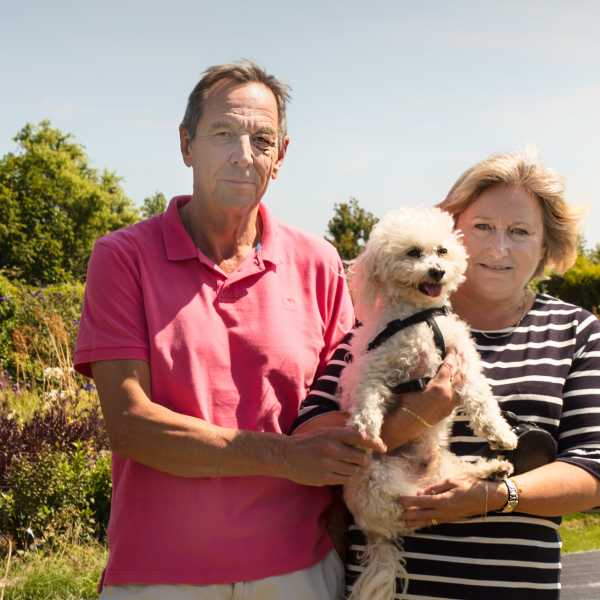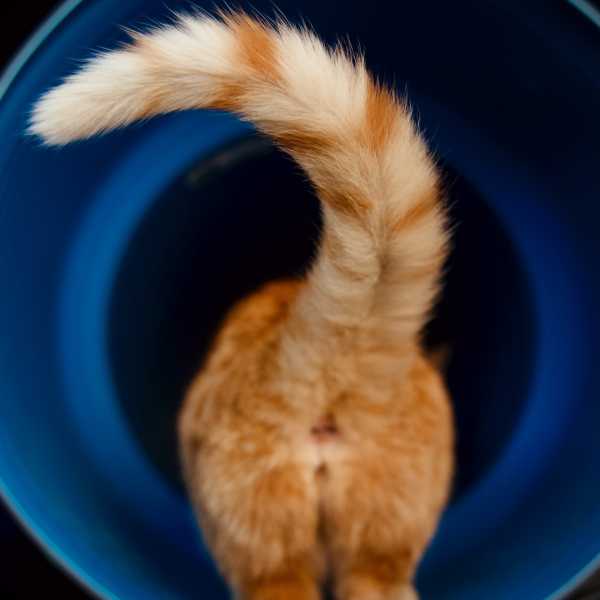
Rabbit Welfare Association & Fund - Outdoor rabbit housing
Posted on 3 May, 2021
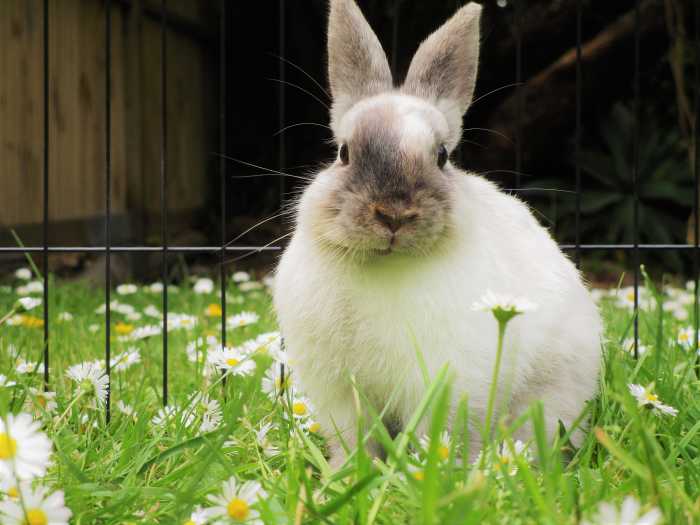
Photo by Misha Walker on Unsplash
Written by Rabbit Welfare Association & Fund
Rabbits can be perfectly happy living in the house or the garden just so long as their physical and behavioural needs are catered for.
This means that they need a lot more than just a hutch! Our recommendation for a pair of average size rabbits is a single enclosed area of at least 3m x 2m by 1m high. This can include the sleeping quarters, and makes up a footprint (accessible area of the ground or floor) of 3m x 2m.
For those who prefer imperial measurements: 3m=9’10”, 2m=6’7″, 1m=3’3″.
Just to be clear, the minimum space we recommend refers to the ground space available in the main enclosure. The upper floor of a two-storey hutch does NOT count towards the footprint. Similarly, whilst raised platforms, tunnels and other connected areas are great for enrichment and are actively encouraged, they do not count towards the footprint, they are a nice bonus.
Just as with a healthy diet, a rabbit’s environment has a huge influence on its health and well-being. A caged rabbit can develop skeletal problems, sores and is more likely to be overweight. Check our note on environment and health by Specialist vet Richard Saunders.
Let rabbits be rabbits
Think about how rabbits behave in the wild.
They need 24/7 access to a safe environment that allows them to do all of this:
- Running
- Digging/Burrowing
- Jumping
- Hiding
- Foraging/Grazing
- Stretching up on their hind legs
- Lying fully stretched out
- Binkying
Size is important
If you choose a traditional hutch as a bedroom for your rabbits, it needs to be big enough for a rabbit to take 3 hops and to stretch fully upright. For most breeds this will mean a hutch of 6ft long x 2ft tall, so we recommend a hutch no smaller than 6ft x 2ft x2ft. In metric this is 1.8m x 0.6m x 0.6m high.
The hutch or sleeping area can be attached to or inside the secure enclosure of at least 3m x 2m x 1 metre tall. If the hutch is inside the enclosure the rabbits should never be shut inside it, they should be able to move between their sleeping quarters and exercise area whenever they choose.
But you don’t have to go for a hutch and run, there are other options available. More rabbit owners are being creative to give their rabbits the home of their dreams. Garden sheds can be converted, for example.
Room to roam
Rabbits are active animals, and can develop painful skeletal problems if kept permanently caged so daily exercise outside the hutch is vital. A hutch should only ever be a shelter, never the sole or main accommodation for your rabbits. For this reason we recommend a large hutch or shed with an exercise run permanently attached. This means that the rabbits can decide when they want to shelter, and when to play.
Rabbits are “crespuscular” which means they are most active at dawn and dusk – so lifting them from hutch to run for a few hours in the daytime just doesn’t suit their body clocks and instincts. Having the hutch and run permanently attached also means you can have a Sunday morning lie-in without feeling guilty!
Security
The enclosure must be secure. If it’s outside then it has to keep out foxes and other predators so the mesh and bolts must be of a good quality. Go for welded mesh of a heavy gauge, not chicken wire, which they can bite through. Use a bolt you can padlock.
Give a lot of thought to the wire. There is a gauging system for thickness of wire and the lower the number, the thicker the wire. 16g (1.2mm) is the minimum we recommend. And 12g is even better. Ensure that the wire is properly fixed to the wood. If it’s a single layer of wire it is safer to be attached on the inside of the run rather than the outside.
The size of the holes in the wire is important. 13mm is perfect, but most commercially produced enclosures will have a 25mm gap. This will keep out foxes and rats but not smaller predators.
Stoats, polecats and weasels are a danger to rabbits, with weasels being the smallest. If these are concern, either build an enclosure yourself with 13mm mesh, or add another layer of mesh to the outside of the existing frame.
Be aware of some exercise runs that have caused death or injury to the rabbits who have got their heads stuck in the mesh. Always read the reviews!
The staples that hold the wire to the wood must be as strong as possible so go for the sturdiest you can find.
Location
The enclosure should be out of direct sunlight and at least partially covered to protect your rabbits from the elements. Run covers are available commercially and tarpaulin can be bought quite cheaply from garden centres.
Rabbits whose exercise run is on a lawn will enjoy access to grass every day, which is great for their teeth and digestive systems and will keep them busy. Recent research also shows that rabbits on grass are less likely to suffer from sore heels. But be aware that unless you take appropriate precautions, they are likely to dig their way out, which could put them at risk from predators. So if you have your run on grass, either make sure you fill the holes regularly, fit a wire-mesh skirt, or place paving slabs around the perimeter to make it more difficult for your rabbits to tunnel out. Check regularly to see if they have any escape tunnels on the go and take appropriate action.
So, if you have your run on grass, either make sure you move or fill it it regularly, fit a wire-mesh skirt, or place paving slabs around the perimeter to slow them down and make it more difficult for your rabbits to tunnel out.
Rabbits with enclosures on concrete, slabs or decking (or in grass runs with a wire mesh skirt around the perimeter) will not be able to dig out, making them more secure. But because digging is a natural behaviour, you will need to provide them with an alternative: a digging pit, which could be a large litter tray or planter filled with earth. This will need to be changed regularly.
Chewing
Most rabbits will chew on hutches or runs. Make sure the wood hasn’t been treated with something toxic. Modern paints are safer than older ones but ideally they shouldn’t eat it. If you are treating the wood with a timber preservative, ensure it’s safe for pets and has dried and been sanded before your rabbits get near it. If their chewing is making a hutch or run start to fall apart, there is a danger of them getting out, or of predators getting in. Keep all housing in good repair.
Chemicals
Weedkillers, slug pellets, fertilisers and various other chemicals found in many gardens are toxic to rabbits, very many of them deadly. Keep them locked safely away, or better still investigate some ‘green’ methods of gardening that don’t involve poisons. For example, instead of slug pellets, which kill anything why not use slug nematodes? They are for sale on several gardening websites and are safe for all other species, including rabbits, humans, garden birds, frogs, fish and your other pets.
Enrichment
Enrichment is what rabbits need to be able to act like rabbits. If your rabbits are on concrete or indoors then they will need a digging tray. They will also need hidey holes and tunnels. Check out our enrichment advice for some great ideas to keep your rabbits occupied and content.
Here’s one we made earlier
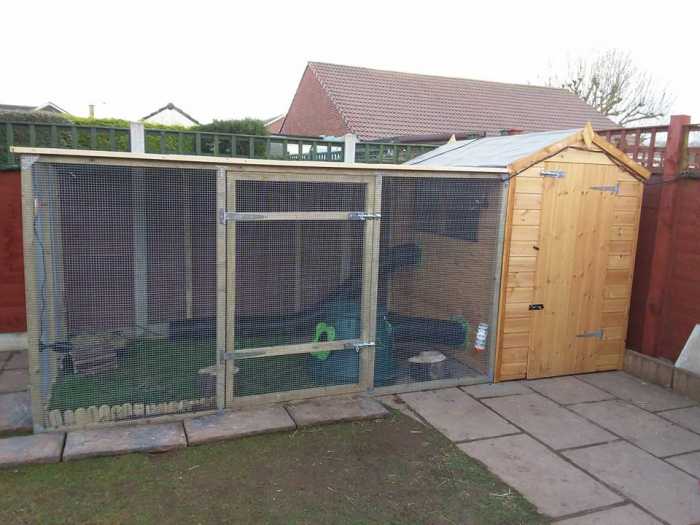
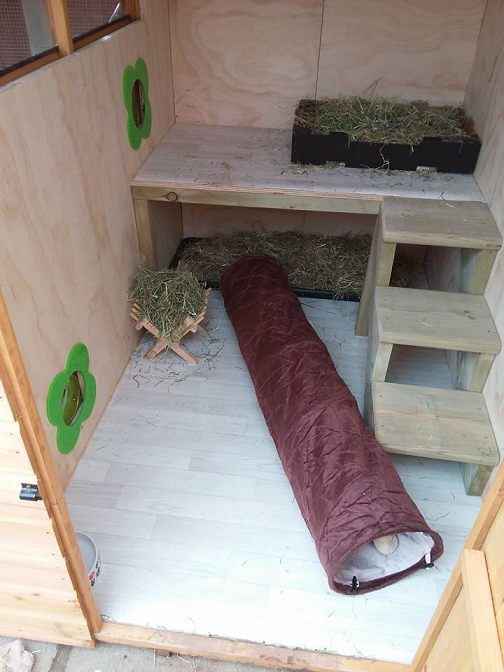
Images above sourced from Rabbit Welfare Association & Fund.
This set up has everything in it that the rabbits would need. The shed is converted. There are 2 bolts on the door, top and bottom for extra security. We have used 12g 13mm wire attached by strong galvanised wire staples. There is a felt roof for protection and there is wire sunk under the grass area. There are 2 holes for entrance / exit between the shed and the exercise area.
Inside the run you will see we have given the rabbits:
- Platforms to sit on and look for danger. This also allows them to stretch and jump
- Grass to graze and access to clean, dry hay at all times
- Hiding places
- A place to dig
- Space to sit apart from each other if they want to
- Plenty of space to run, jump and binky.
Bedding
In the wild, rabbits live in underground warrens where the temperature does not vary much between winter and summer. We need to bear this in mind for pet rabbits. The sleeping area should always be warm, dry and draft free. There are lots of good bedding materials on the market now such as Megazorb and Auboise. Straw should be used as bedding rather than hay because it is warmer and is a bedding material rather than food. Make sure you get soft, dust extracted bedding straw so that you minimize the risk of eye injuries and avoid a dusty environment. You will of course still need to give your rabbits plenty of fresh hay to eat.
And of course because they have a companion they will each have the equivalent of a furry hot water bottle next to them!
To find out more and read the original article, please visit: https://rabbitwelfare.co.uk/rabbit-care-advice/rabbit-housing/outdoor-rabbit-housing/
Tags:


